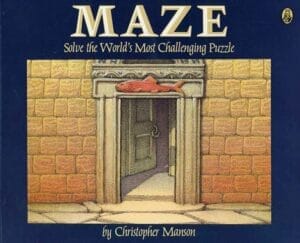By Langdon Hickman
A discussion I frequently have with writers is a question of speculative formalism, a fancy term for thinking of forms or structures we think maybe are weak, even quite weak, and how we might do them better. This kind of question seems on its surface like something only a writer would care about, looking at genres or approaches to genres and mechanically troubleshooting them instead of just deciding if the project is worth your time or not. But the value of this exercise is twofold, even for a reader who doesn’t write often or at all.
First, you can think about works better as a reader and gain more from them, but also second, you can increase your sensitivity and awareness of elements already present in works that you like or are interested in. One of the classic approaches, say, of masters and PhD studies in literature is taking a text you already know and have written on and peeling back more and more layers, structural components, historical and genre components you may not have immediately recognized. It’s in this light that the question of coziness becomes interesting to me and I think the most immediately gainful figure to tap on for this is Italo Calvino.
Invisible Cities, a novel written in a mosaic-like assemblage of a million little pieces, immediately comes to mind. In this novel, there is barely anything that could be construed as a conflict, at least in the traditional sense. Marco Polo, safe within the camp of the Yuan emperor Kublai Khan, begins describing his journeys to China and the many, many mystical cities he saw along the way. Each of the chapters is a page or two, nothing but descriptions of these beautiful towns, paintings in miniature. By the end of the novel, it becomes clear that all of these cities are in fact just Venice, with the inventive Marco Polo highlighting different aspects and angles of his home city, delivering them with enough richly crenelated detail to make them seem like separate cities entirely.
The relation of this to cozy fiction is immediately apparent. It is not just that conflict is sparse if non-existent; the mood of the shorter pieces is likewise cozy or, in the words of Calvino in his essay book Six Memos for the New Millennium, light and witty. It’s important for us to consider however why this was effective. It’s not the coziness that presents a problem but rather what the aims and prosaic achievements of a text are, how it wields itself toward its subject matter, which shifts whether a conflict-averse text is refreshing and linguistically rich or a frustrating aimless slog. In the case of Invisible Cities, it achieves this end through great specificity of language and image. The focus isn’t on flippantly stating a calming tone but instead spending slow, deliberate time chronicling details of these cities, like the city of shells, the city on stilts, the city of water, etc. Attention is also paid by Calvino not to any old detail; it is not enough to simply have endless pages describing the color and patterns of clothes and the make of buttons. Instead, there is a crystallized focus on very economically compact visual and sensory details, things that on one hand are purely literal descriptions but on the other chosen specifically because of their evocative power. As to why this doesn’t come across as saccharine and twee, the key failures of cozy fiction at its worst, this is because the text sets itself toward wonder and curiosity, giving the framing meta-“conflict” of how these miniatures like scales of a fish will assemble into a directed vision or assemblage, not just an aimless accumulation of details.
We can dial this in further by looking at two other similar short novels by Calvino, Marcovaldo and Mr. Palomar. The former is a picaresque following the lightly comedic exploits of a working class Italian man and the latter is a series of hybrid pieces spanning from the very specific and intimate to the very abstract and philosophical. Both of them adhere to the general form of Invisible Cities however, following a tone of detail-driven portraiture of a space or moment rather than a conflict and its resolution and as a result cultivate a light, “cozy” space. The insulated chapters of Marcovaldo contain minor conflicts, but of a witty sort. The opening chapter, for instance, is of Marcovaldo seeing pigeons on his roof and, given the economic pressures in Italy of the time, decides they would make good food. Thus, he and his son spread glue over the roof to catch a flock, which works far too well and leaves a mass of screaming birds on their roof and a furious superintendent. Mr Palomar similarly has insulated chapters, being driven more by its structural conceit, a 3×3 logic square where the columns and rows are each labeled personal-social-philosophical, creating 9 chapters following each potential pairing. In one, he buys cakes, while in another, he attends the zoo, and in yet another he falls into deep, rich pondering about the parallels of death, mirror to itself before birth and after life, following a chapter regarding the universe as a mirror.
The driving factor in these novels is precisely that which generates their innate coziness: a deep and abiding intimacy. This comes not by the heavy hand insisting upon a coziness but instead upon a richness of fine-grain specific details, an affect borrowed from naturalist writing of the 1800s (another rich vein worth exploring regarding successful literary executions of the cozy). In “The Written World and the Unwritten World”, Calvino himself cites two specific literary traditions, the first being the literature-for-itself language driven writing of the Parisian school and the literature-as-record-of-world realist/naturalist model of Vienna. At their most extreme, we could see the former terminating in something like Finnegans Wake, a cathedral dedicated to language itself, while at its extreme the latter might be Vassily Grossman’s Stalingrad duology, which while literary skew more toward macro scale detail dense descriptions of a time, a place and a life. Italian writing, per Calvino, lies somewhere between these two poles (as does most literature). This, as he describes it, is the root of the Italian fabular style, the part-romantic part-realist writing that marks him, Umberto Eco, Primo Levi and the like.
It is also precisely here that we can mechanically and literarily understand how a successful coziness comes about. The misconception is that it comes purely from an uncomplicated romanticism, but overplaying this hand can lead to a hackneyed and tedious read that only affects those already enchanted. The fable and thus the cozy sources itself in the intimate, discreet details of a real lived life, like the feeling of wood grain of a table under your hands, the way light streamed through the kitchen window onto the slow-breaking chair pressed against the wall, the flecking and fading paint of the fruit bowl left in the center when there wasn’t a meal, etc. Only after establishing these fine painterly details, already brimming with a kind of natural romanticism, does Calvino then begin to gently gloss and glaze them with a misting of additional romance and curling language.
A fitting final example is the lo-fi beats to study/relax to video. There has been lots of spilled ink regarding misuses of Ghibli visual aesthetics, but this video lands successfully, feeling a bit like an older Kiki after the loss of the magic, enmeshed in the common life of the real. But the sentimentality evoked by it is not incidental or based on that liminal nostalgia, but instead by the richly detailed room we can see. It has everything of a real and common life: disheveled books, scattered papers, a half-open window looking at a mundane and too-real adjacent building, the nonchalant swish of the cat’s tail, the headphones so real you can imagine them on your own head, the way the band pinches your skull. There is an immensity to the detail work, but it is all rendered with a light touch, emphatically not insisting upon itself. It conjures by its presence a space so intimately familiar that you can place yourself there automatically without being compelled to. That is true literary coziness, and you don’t even have to open a coffee shop to create it.





